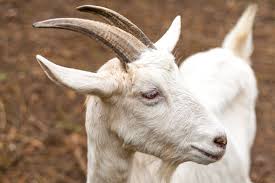

Goats’ horns grow every year, so become longer and more curved as they age. The first two years show substantial growth; thereafter, growth is thicker but less deep. In some goats, you can actually see changes in texture or shade on the surface of the horns marking the different growing seasons, so you can literally count the rings! Often this is more defined between some years than others, so it is not an easy reckoner. Growth and ease of assessment vary between breeds and individuals.
Although kids mature sexually within a few months, they continue to develop and grow until they are three or four years old. When you are familiar with the genetic line of your herd, you will recognize maturity in the frame size and muzzle width of your goats. As goat teeth develop, their muzzles may appear fuller and rounder. Early development issues may confuse your assessment: sick, stressed, or underfed kids hardly grow, and will be smaller than average. Goat weight and size are very much affected by nutrition and exposure to disease and parasites. Genetics also have an effect, as some breeds are selected to be fast growing.
If you have a goat with a beard, you may notice this lengthen and thicken with age. A goat beard may start with a few tufts in the yearling, and develop to a fuller luxuriousness at two or three years old.
Most goats bear calluses on the foreleg joints we term goat “knees” (although they are anatomically equivalent to our wrists). Kids, and normally yearlings, have beautiful furry goat knees that are gradually rubbed to calluses through use. Goats whose feed troughs are too low for comfortable feeding may kneel excessively.
A goat walking on knees is severely lame and cannot bear weight on the front hooves. This may be a sign of Foot rot or other hoof problems. Most goats have developed calluses by two years old, and wear varies greatly, depending on activity and environment. However, be aware that large calluses may indicate past or current discomfort.
Goat knees frequently click, especially in goats four or more years old. Although normally there is no pain at this stage, goats can develop osteoarthritis, just as we can.
Feral goats are at their peak at five to six years old and will decline thereafter. Well-cared-for domestic goats who are not worked too hard generally stay in good condition for longer, and they may not noticeably lose muscle tone until they approach old age. To maintain this level of health they need good nutrition, suitable housing, routine care, regular exercise, and mental and social stimulation. To this end, we need to ensure that we know what to feed goats, how to house goats, the basics of caring for goats, how to treat goat diseases, how to create goat play grounds and how to emulate their natural social lives.
 Contact Jaguza Support
Contact Jaguza Support